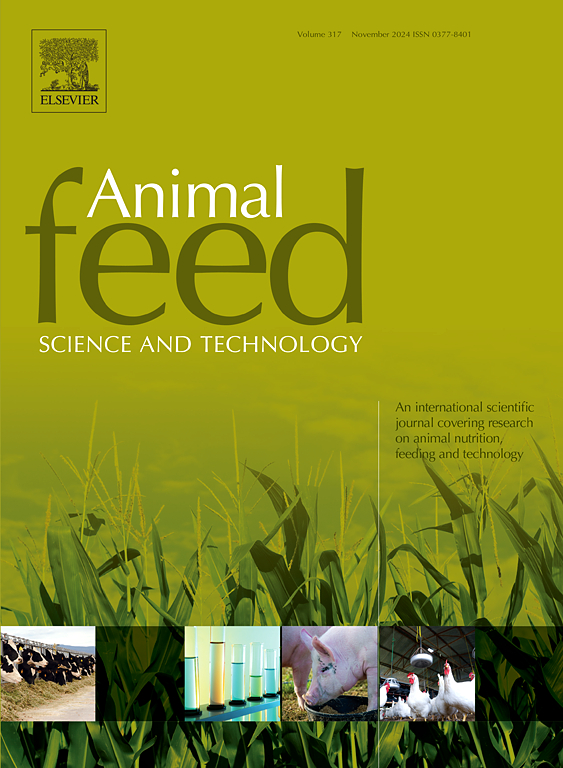饲料中添加发酵酵母产品(Saccharomyces cerevisiae)对尼罗罗非鱼(Oreochromis niloticus)生产性能、健康状况和微生物组的影响以及长叶莴苣(Lactuca sativa)生产过程中排水量的影响
IF 2.5
2区 农林科学
Q1 AGRICULTURE, DAIRY & ANIMAL SCIENCE
引用次数: 0
摘要
水培系统的基础是将鱼类废物转化为植物基质;因此,饲料输入是管理水质和优化性能的关键组成部分。本研究通过将生物群落系统与深水水培装置相结合,评估了发酵酵母产品(Saccharomyces cerevisiae)对尼罗罗非鱼(38.63 ± 2.01 g)和生菜生长、健康和微生物组的影响。分别饲喂三种不同的饲料,每种饲料由三个重复组成:基础饲料中含有32% %粗蛋白质和8% %脂肪,饲料中含有2% % DVAQUA®,饲料中含有0.1% % NutriTek®。在鱼类和植物生长试验中,没有观察到不同处理之间的明显生长差异。叶面组织检查显示,nutritek处理的长叶莴苣植株的镁含量显著高于基础日粮处理的植株(P = 0.031)。根据Kaplan-Meier生存分析,在接受黄杆菌攻击后,饲喂DVAQUA和NutriTek的鱼的存活率高于饲喂基础饲料的鱼(P <; 0.001)。血清溶菌酶活性没有发现差异,但脾脏和肾脏组织中的免疫相关标志物在攻毒前后表现出差异。当细菌社区进行了分析,在α多样性指数差异被发现在两个鱼粪便样本(香农多样性指数- P & lt; 0.001,曹国伟- P & lt; 0.001和观察到的物种 = 0.001页)和根样品(香农多样性指数- P & lt; 0.001,曹国伟- P & lt; 0.001和观察到的物种P = 0.005)之间治疗(P & lt; 0.05)。粪便样品中最丰富的门是梭菌门,而根样品中最丰富的门是蓝藻门。综上所述,饲料中添加发酵酵母产品可提高尼罗罗非鱼的抗病性,并影响粪便和根部微生物组的细菌组成。本文章由计算机程序翻译,如有差异,请以英文原文为准。
Influence of dietary fermented yeast products (Saccharomyces cerevisiae) on performance, health and microbiome of Nile tilapia (Oreochromis niloticus) and the influence of discharge water in the production of romaine lettuce (Lactuca sativa)
Aquaponics systems are based upon the conversion of fish waste into plant substrates; thus, feed input is a critical component to managing water quality and optimizing performance. The current study assessed the effects of fermented yeast products (Saccharomyces cerevisiae) on Nile tilapia (38.63 ± 2.01 g) and romaine lettuce growth, health and microbiome by combining a biofloc system with a deep-water hydroponic setup. Three distinct diets, each consisting of three replicates, were fed to the fish: a basal diet with 32 % crude protein and 8 % lipid, a diet having 2 % DVAQUA® inclusion, and a diet containing 0.1 % NutriTek®. No discernible growth differences across treatments were observed in the fish and plant growth trials. Foliar tissue examination showed that NutriTek-treated romaine lettuce plants had noticeably greater magnesium levels than the basal diet treated plants (P = 0.031). Following challenge with Flavobacterium oreochromis, fish fed DVAQUA and NutriTek exhibited greater survival than those fed the basal diet (P < 0.001), based on Kaplan-Meier survival analysis. No differences in serum lysozyme activity were found, but immune-related markers in the spleen and kidney tissues displayed differences pre- and post-challenge. When bacterial communities were analyzed, differences were found in alpha diversity indices in both fish fecal samples (Shannon diversity index- P < 0.001, Chao – P < 0.001 and observed species P = 0.001) and root samples (Shannon diversity index- P < 0.001, Chao – P < 0.001 and observed species P = 0.005) between treatments (P < 0.05). The most abundant phylum presented in fecal samples was Fusobacteria, whereas Cyanobacteria was the most abundant for root samples. In conclusion, feeding fermented yeast products as dietary supplements improved resistance to disease in Nile tilapia and influenced the bacterial composition in both the fecal and root microbiome.
求助全文
通过发布文献求助,成功后即可免费获取论文全文。
去求助
来源期刊

Animal Feed Science and Technology
农林科学-奶制品与动物科学
CiteScore
6.00
自引率
6.20%
发文量
266
审稿时长
3 months
期刊介绍:
Animal Feed Science and Technology is a unique journal publishing scientific papers of international interest focusing on animal feeds and their feeding.
Papers describing research on feed for ruminants and non-ruminants, including poultry, horses, companion animals and aquatic animals, are welcome.
The journal covers the following areas:
Nutritive value of feeds (e.g., assessment, improvement)
Methods of conserving and processing feeds that affect their nutritional value
Agronomic and climatic factors influencing the nutritive value of feeds
Utilization of feeds and the improvement of such
Metabolic, production, reproduction and health responses, as well as potential environmental impacts, of diet inputs and feed technologies (e.g., feeds, feed additives, feed components, mycotoxins)
Mathematical models relating directly to animal-feed interactions
Analytical and experimental methods for feed evaluation
Environmental impacts of feed technologies in animal production.
 求助内容:
求助内容: 应助结果提醒方式:
应助结果提醒方式:


